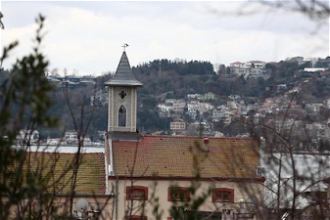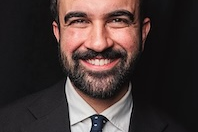Pilgrimage to Constantinople

Pope Benedict XV
The group Friends of the Holy Father recently visited Turkey. Dr Michael Straiton KCSG sends this report.
Despite the systematic dismantling by the Ottomans of vestiges of Christianity in Constantinople, now Istanbul, there is still much to see. 40 Friends including seven priests, led by Fr Nicholas Kavanagh, made the pilgrimage in October. We recalled several famous popes who had had experience in the City and also recalled and honoured two Fathers of the Eastern Church, St John Chrysostom and St Gregory the Theologian from Nanzianzus. We celebrated daily Mass in some of the city's modern Catholic churches, where we were kindly welcomed by the priests who described to us their work in these flourishing parishes.
The buildings of Constantine have mostly vanished, to be replaced in the 6th century by the incomparable temples raised by the Emperor Justinian the Great. The most breathtaking of all, the Church of Haghia Sophia, Justinian's triumph, built by him in just five years and consecrated in AD537, retains some magnificent Byzantine mosaics, whereas the church of Haghia Eirene - Holy Peace - has been stripped of decoration. The Great Palace has completely disappeared above ground, but one enormous mosaic floor preserved in situ below the Mosaics Museum, gives a glimpse of life in the Byzantine city when at the zenith of its power. The huge Column that Constantine raised to commemorate the foundation of his 'New Rome' in 330 survives, but is situated today in a municipal coach park.
One of the most beautiful of the Byzantine churches is Holy Saviour in Chora that was redecorated in the 14th century with unrivalled displays of mosaics and frescoes recounting episodes in the life of the Virgin Mary and her Divine Son, the finest such Byzantine works to be seen anywhere.
Several popes visited Constantinople. The first was Pope Vigilius I (537-55) who was summoned there by Justinian for doctrinal debates. A few years in 579 Pope Pellagius II sent the monk Gregory, the Abbot of St Andrew's monastery in Rome, as his ambassador to the Imperial Court to seek military help to withstand the threat of the pagan Lombards who were endangering Rome. He stayed there for seven years but the embassy was ultimately unsuccessful and he returned to Rome. He was elected Pope in 590, later to be acclaimed as Pope St. Gregory the Great. For centuries after there was no papal visits to Constantinople.
Pope Benedict XV served his pontificate in search of peace and the relief of suffering during the First World War (1914-18), sending representatives to both sides in the quest for peace. He helped to establish a hospital on the Turkish-Syrian border where wounded Turkish soldiers were treated. On the Pope's death in 1922 the Turkish State raised a large bronze statue in his honour in the courtyard of the Cathedral of the Holy Spirit in Istanbul with a dedicatory plaque to the 'benefactor of all people, regardless of nationality or religion'.
Mgr Angelo Roncalli, later to become Pope John XXIII, was apostolic nuncio to Turkey during the Second World War, 1939-45. He learned Turkish and used it in the liturgy and in official documents which earned him the respect of government officials. Turkey remained neutral and Istanbul became a centre of international intrigue and espionage. The nuncio was well placed to carry out the instructions of Pope Pius XII in the cause of peace and the relief of suffering millions. He worked closely with Chaim Barlas, the director of the Jewish Agency Rescue Committee in Istanbul, in sending the Pope's interventions to many countries under Nazi domination. He used private couriers, Turkish diplomats, truck drivers and businessmen to carry messages and money across war-torn Europe. He sent thousands of Turkish visas, Palestinian immigration certificates, even 'temporary' baptismal certificates to Hungarian Jews to enable them to join those who were fleeing through Turkey to Palestine.
Pope Paul VI was the first pope in centuries to meet the heads of various Eastern Orthodox faiths. His meeting with Ecumenical Patriarch Athenogoros I in Jerusalem in 1964 led to the rescinding of the 1054 excommunications that led to the Great Schism. They met again in Istanbul in 1967 and on that occasion, on entering Haghia Sophia, the Pope dropped to his knees in prayer. This caused a furore as the building had been recognized for years as a secular museum.
One of the first visits outside Rome by Blessed Pope John Paul II was to Istanbul in 1979 to meet the Ecumenical Patriarch of Constantinople, Demitrios I. The two announced the establishment of dialogue between the Orthodox and Catholic Churches, the first such deliberation since the Council of Florence (1431-45).
After a visit to Haghia Sophia during his stay in Istanbul in 2006, Pope Benedict XV joined the Grand Mufti in prayer at the Blue Mosque, the second Roman Pontiff to visit an Islamic house of worship; previously Pope John Paul had visited the Umayyad Mosque in Damascus.
We called at the Cathedral of St George at the Ecumenical Patriarchate in the Phanar district of Istanbul, where we followed the tradition of kissing the icon in the atrium and lighting a candle before entering. We venerated the relics of two of the most important of the eastern patriarchs, St John Chrysostom and St Gregory of Nanzianzus, both 4th century Archbishops of Constantinople. Their relics had been in Rome since the 8th century and were returned to the Patriarchate by Pope John Paul II in 2004.
One of the most famous railway lines built in the 19th century connects Paris and Venice to Istanbul for the Orient Express. We had lunch at the terminus, the marvelous Sirkeci Station, and later went to the Pera Palace Hotel, the fabulous destination of the rich and famous, including King Edward VIII, King Boris of Bulgaria who insisted on driving the train himself while it passed through his country, Ernest Hemingway, Greta Garbo and Agatha Christie. Finally in the Orient Bar we sipped and savoured our pre-prandial cocktails to the strains of evocative 20's music.
A wonderful cruise on the Bosphorus ended at a waterfront restaurant in Üsküdur on the Asian side of the channel, where we were able to survey the magnificent skyline with so many domes, minarets and palaces of this great city - an unforgettable memory of our pilgrimage.
For more information on Friends of the Holy Father see: http://friendsoftheholyfather.com/


















